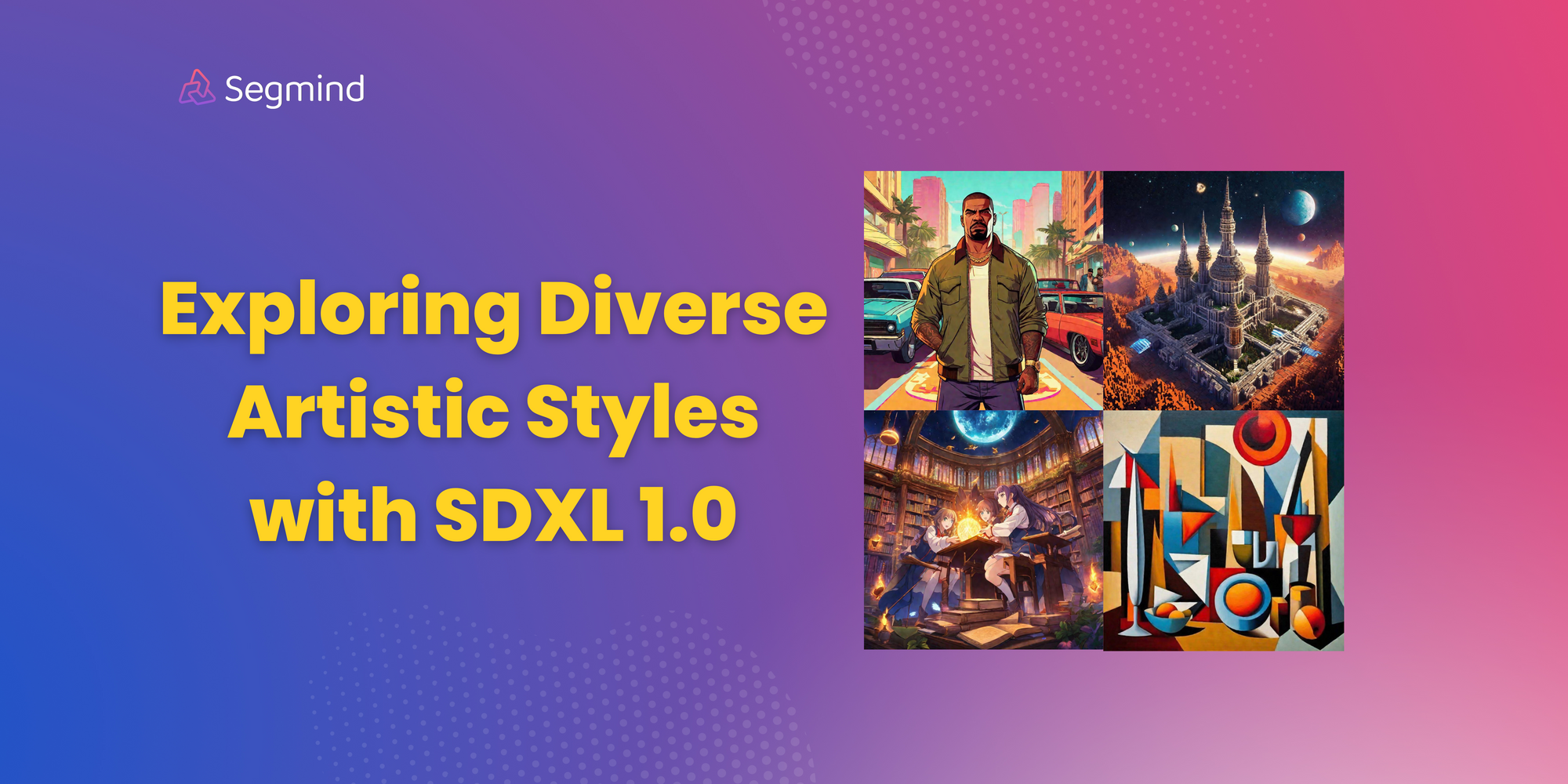Exploring Diverse Artistic Styles with SDXL 1.0
Explore different artistic styles through Segmind's SDXL 1.0 model.

Art is an incredible mosaic, reflecting the myriad hues of human imagination and creativity. In exploring artistic styles, we venture into the varied landscapes of expression and interpretation. In this blog, we will go through the realms of anime, cyberpunk, fantasy, and more as we unravel the unique allure of each style with SDXL 1.0.
Anime
Anime encompasses various animated styles from Japan, known for its vibrant characters, imaginative worlds, and compelling storytelling. It spans various genres, captivating audiences with its unique artistry and cultural significance.

3D Models
3D modeling is a digital art form that uses specialized software to create three-dimensional representations of objects, characters, environments, or concepts. It's widely used in various industries like gaming, animation, architecture, and product design. Artists manipulate digital polygons to sculpt, texture, and render realistic or stylized 3D models, bringing imagination to life in a virtual space.

Comic Book
Comic book style in visual art mirrors comic illustrations' vibrant, dynamic, and expressive qualities. It often features bold outlines, vibrant colors, exaggerated expressions, and dynamic action sequences reminiscent of the storytelling techniques used in comic books.

Cyberpunk-Game
The Cyberpunk Game style embodies the essence of interactive narratives set in dystopian, technologically advanced worlds. It merges the aesthetics of cyberpunk with the immersive and dynamic elements of gaming. These games often feature sprawling futuristic cities, complex storylines involving corruption and rebellion, and protagonists navigating a web of cybernetic enhancements, hacking, and action-packed sequences.

Architectural
The architectural style encompasses the art and science of designing and constructing buildings, structures, and environments. It emphasizes functionality, aesthetics, and innovation, often reflecting cultural, historical, and technological influences. Architectural design involves the thoughtful arrangement of spaces, materials, and forms to create harmonious and functional structures that interact with their surroundings.

GTA
The GTA (Grand Theft Auto) style embodies an open-world, action-adventure gaming experience known for its sprawling cities, criminal underworlds, and immersive narratives. It features a sandbox environment where players navigate fictional cities, engaging in various criminal activities, missions, and exploration. The style captures the essence of urban life, offering players freedom, diverse interactions, and a blend of realism and exaggerated, satirical elements.

Isometric
The isometric style in visual art utilizes a 3D drawing method where objects are rendered with parallel lines to create the illusion of depth and perspective. It often features geometric precision, clean lines, and a sense of uniformity, providing a unique view that combines 2D and 3D elements.

Fantasy Art
Fantasy art transports viewers into realms of imagination, where mythical creatures, epic landscapes, and magical elements reign supreme. It encompasses diverse themes, from enchanted forests and ancient ruins to mystical creatures and heroic quests. This style often showcases vibrant colors, intricate details, and a sense of wonder, inviting audiences to explore fantastical worlds beyond reality.

Space
The space style encapsulates the vast and wondrous universe beyond Earth's atmosphere. It explores celestial bodies, cosmic phenomena, and the mysteries of outer space. This style often showcases breathtaking depictions of planets, galaxies, starscapes, and futuristic concepts, aiming to evoke a sense of awe, curiosity, and the unknown.

Minecraft
The Minecraft style is characterized by its blocky, pixelated aesthetic and limitless creative potential within a sandbox environment. It celebrates simplicity in design while offering boundless opportunities for creation. It's known for its cubic shapes, vibrant colors, and the ability to construct entire worlds, structures, and landscapes using textured blocks.

Retro Arcade
The retro arcade style embodies classic games' vibrant and nostalgic aesthetic from the 1980s and 1990s. It features bold, colorful visuals, pixelated graphics, and fast-paced gameplay. This style often incorporates neon lights, pixel art characters, and catchy soundtracks, evoking a sense of nostalgia for the golden age of arcade gaming.

Monochrome
The monochrome style uses a single color or shades of a single color to create artistic compositions. It emphasizes contrast, texture, and lighting to convey depth and emotion. Monochrome artistry can evoke a sense of timelessness, elegance, and simplicity by utilizing the interplay of light and shadow within a limited color palette.

Lowpoly
The lowpoly style in visual art utilizes a minimalistic approach, employing a limited number of polygons to create geometric shapes and forms. It often features flat surfaces, sharp edges, and simplified structures, resulting in a stylized and abstract representation of subjects.

LineArt
Line art focuses on using lines or outlines to represent subjects, often emphasizing contours, shapes, and intricate details without utilizing color or shading. It’s characterized by using various line weights, textures, and patterns to create visual interest.

Photographic
The photographic style in visual art replicates the characteristics and aesthetics of real-life photography. It aims to emulate photographs' look, feel, and nuances, often portraying realistic scenes, subjects, or landscapes.

Food Photography
Food photography style involves capturing images of food in a visually appealing and appetizing manner. It emphasizes various cuisines' presentation, colors, textures, and details to evoke hunger and sensory appeal.

Horror
The horror style delves into fear, suspense, and the macabre. It aims to evoke intense emotions through eerie atmospheres, chilling narratives, and unsettling visuals. This style often explores dark themes, supernatural elements, and psychological aspects, seeking to immerse audiences in a world of dread, suspense, and the unknown.

Watercolor
Watercolor art involves using water-based pigments to create vibrant and translucent paintings. It's characterized by its fluidity, delicate washes, and the unique blending of colors. Artists often use layering, wet-on-wet, and dry brush techniques for various textures and effects. The style exudes a sense of spontaneity, allowing for both controlled precision and free-flowing expression.

Cinematic
Cinematic style in visual arts mirrors film's aesthetic qualities, aiming to create still images that evoke the atmosphere, framing, and storytelling techniques used in movies. It emphasizes dramatic lighting, compelling compositions, and a sense of narrative depth to evoke emotions akin to those experienced in a movie.

Summary
We delved into diverse artistic styles, showcasing the SDXL 1.0's versatility and proficiency in generating various visual genres. Through the lens of SDXL 1.0, we explored an eclectic mix of artistic styles, from Anime and Cyberpunk to Monochrome and Horror art. Each style presented a unique challenge, yet SDXL 1.0 consistently demonstrated its adaptability and ability to encapsulate the essence of each genre.
Further Readings:

